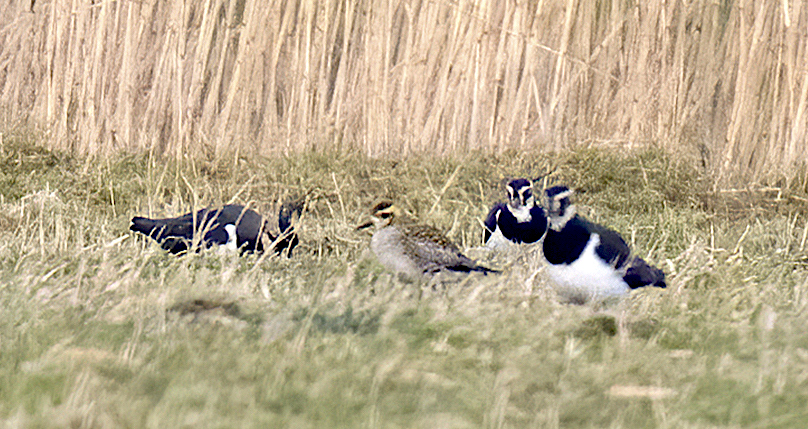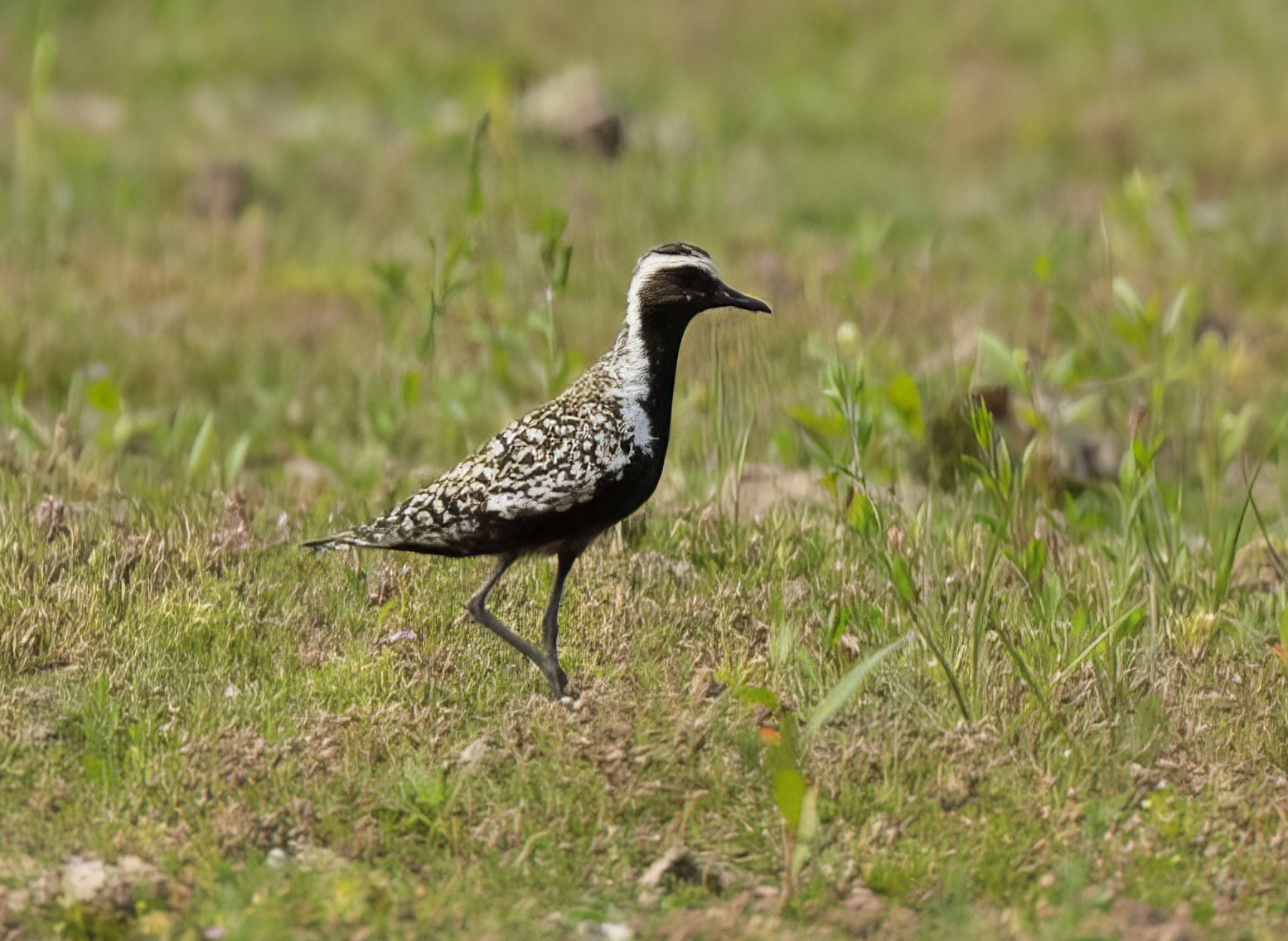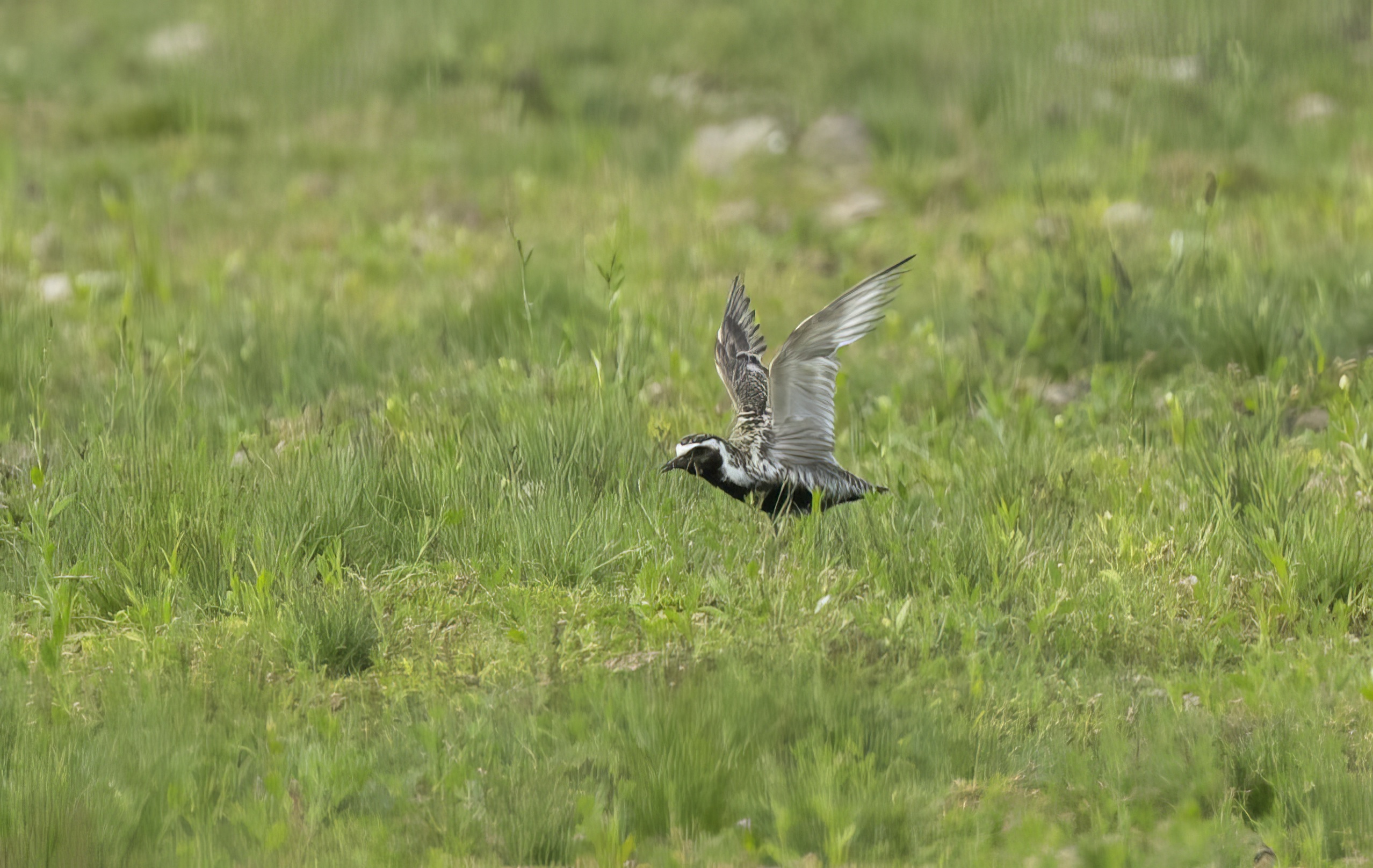Pacific Golden Plover Pluvialis fulva



| Site | First date | Last date | Count | Notes |
| Tetney/North Cotes | 21/07/1986 | 29/07/1986 | 1 | Adult |
| Tetney/North Cotes Point | 03/08/1986 | 08/08/1986 | 1 | Same |
| Tetney/North Cotes | 18/08/1986 | 19/08/1986 | 1 | Same |
| South Ferriby | 02/07/1993 | - | 1 | Adult |
| South Ferriby | 18/07/1993 | 19/07/1993 | 1 | Same |
| South Ferriby/ Read's Island | 10/07/1994 | 11/07/1994 | 1 | Adult |
| Horseshoe Point/ North Cotes | 17/07/2002 | 18/07/2002 | 2 | Adults |
| Alkborough Flats | 29/01/2015 | - | 1 | 2CY+ |
| Frampton Marsh | 19/07/2021 | 04/08/2021 | 1 | Adult |
| Frampton Marsh | 05/08/2021 | 16/08/2021 | 2 | Adults |
| Frampton Marsh | 17/08/2021 | 26/08/2021 | 1 | Adult |
| Deeping Fen | 06/11/2021 | 10/11/2021 | 1 | 1CY |
Finder’s report: Pacific Golden Plover, July 21st, 1986, first county record.
by T. Baker
Note: This account is based on the article which first appeared in Lincolnshire Bird Report 1986 and the BBRC submission. This record first appeared in the BBRC report 1988 after the splitting of Lesser Golden Plover Pluvialis dominica into American P. dominica and Pacific P. fulva Golden Plovers. It was the first for Lincolnshire and 7th for Britain.
Circumstances
At 11.45 hr, July 21st, 1986, Russell Slack, an RSPB Volunteer Warden, flushed a Golden Plover, Pluvialis sp., from borrow pits alongside the new seawall at Tetney Marshes which showed the dark grey underwings characteristic of ‘Lesser Golden Plover’. It flew to the bank of the Louth Navigation Canal seawards of the tidal lock where he relocated it and watched it until approximately 12.00 hr. at which point it flew off. Having informed Tony Baker, he relocated it at 16.00 hr. feeding on the borrow pits, and it flew over us and on to a sugar beet field to join a small flock of Golden Plover P. apricaria there. The very dark underwing was again seen as the bird landed and contrasted well with the white underwings shown by ‘wing-lifting’ Golden Plover. On consulting the literature that evening RS formed the opinion that the bird was of the Asiatic race fulva (note: soon after, split from American Golden Plover, P. dominica as a full species, Pacific Golden Plover Pluvialis fulva).
On July 22nd, RS saw the bird briefly feeding along the canal bank between 16.10 and 16.15 hr. when it flew off. That evening local birdwatchers were informed of the birds presence and identity and on July 23rd, RS and TB found the bird at the same point on the canal bank and watched it between15.00-15.05 hr. but it proved elusive and flew once along the river before flying off altogether when the obviously long legs, long bill and the dark underwing were noted. On July 24th, Ian Shepherd (IS) and Dave Wright (DW) saw the bird fly low over the borrow pit and then veer off to land on the canal bank out of sight at 14.10 hr. IS and DW relocated the bird there at 14.45 hr. and were joined by RS. IS, RS and DW watched the bird until 15.35 hr. and subsequently TB and RS watched the bird from a parked car from 15.45-15.50 hr. at which point it suddenly flew up to join an overflying group of Golden Plover. As it reached the flock its diminutive size was very striking, much more so than I had expected. It appeared half the size of the Golden Plovers with shorter wings, much smaller body bulk and a much more rapid wing beat. On July 26th the bird was located in a tidal creek and was watched for most of the afternoon by many observers. It was again present in the creek on July 27th when amazingly it was joined briefly by an American Golden Plover.
The plover then followed the same routine of being in the tidal creek at low tide and disappearing at high tide until July 29th, and over these four days it was seen by many hundreds of observers, many of whom though only saw the bird at a considerable distance and hence found the identification less than straight forward. At the end of the day though, we were able to confirm that we had two Lesser Golden Plovers in summer plumage at Tetney which were strikingly different from each other: one showing characters typical of a Pacific Golden Plover (PGP), the other a typical American Golden Plover (AGP). The PGP Plover was seen in the tidal creek from at least 14.30-18.00 hr. and John Marchant reported that he had also seen it on the missile base at around 15.30 hr. He commented that the birds showed a diagnostic difference that we had not appreciated. The greater primary projections on the AGP produced a ‘scissor effect’ where the wing tips crossed over, whilst the shorter primary projection on the PGP produced a blunt-ended effect in comparison. His views of the PGP were however, like so many others, distant and not satisfactory in isolation for certain identification.
It was also seen at Tetney on August 3rd brief, but close views were obtained and when the bird flew it called. This was the first time it had been heard to call as far as we were aware. Interestingly the call was quite different from that of the AGP which had called on our first sighting of it. On August 4th the PGP was present in the tidal creek from 12.45-16.20 hr and again called twice in flight. It was not reliably seen again until August 17th-19th, the last dates when it was recorded. By the end of its stay, it was in an advanced state of moult going into winter plumage. The following description is based on the notes taken by TB and IGS, mainly on July 23rd-24th, with further notes on plumage differences on August 18th by TB.
Description
General appearance – the most obvious differences from Golden Plover were the long legs which were always obvious and probably exaggerated by the diminutive bulk of the body, the long thin bill, which was calculated as longer than the distance from the base of the bill to the eye, and the small head and long neck (recalling Ruff Philomachus pugnax) probably exaggerated by the alertness of the bird. On other occasions the head and neck were sunken and not dissimilar to Golden Plover in shape when the long legs were the only obvious pointer to its identity. In flight with Golden Plovers, it could be seen to be half to two-thirds their size with narrower, shorter wings and a more rapid wing beat. At rest the primaries only projected marginally beyond the tail tip. Plumage recalled summer plumage Golden Plover of the northern race (note: since this time, European Golden Plover is regarded as being monotypic).
Head - forehead pale fawn. Crown brown with paler streaking continuing down to nape, which had a conspicuous pale fawn patch. Supercilium narrow and inconspicuous in front of the eye, behind the eye bright and broad, creamy coloured and extending down the side of the breast.
Upperparts - supercilium extending down the breast side merged at the bend of the wing with slightly whiter flank stripe connecting to white undertail coverts (No noticeable bulge in the white at the bend of the wing was recorded although many observers commented on this feature having seen the bird at about 60m. range in the creek). Mantle, scapulars, and lesser coverts appeared very pale on July 23rd; a rather washed out fawn. In good light on July 24th and August 3rd they showed bright gold spangling very much akin to summer European Golden Plover. Blackish tone to median and greater coverts and blackish primaries created contrast. In flight the upperwing showed a clear wingbar flared at the bend of the wing into a large pale patch (missing greater coverts and inner primaries).
Underparts - dark lores and eyestripe enclosing brownish face merging into black throat. Foreneck, breast and belly to vent solid black, bordered above by an obvious white flank stripe. Flank stripe broken by several black bars, these were prominent in flight on July 23rd and appeared to continue on to the axillaries. Undertail coverts white. Underwing dark grey in flight with slight contrast between sooty axillaries and underwing coverts, and smoky flight feathers.
Bare parts - legs, bill, and eyes blackish.
Call - heard on August 3rd and 4th at Tetney, called about eight times in quick succession, a clear, high-pitched but mellow and sweet and short ‘soo-eet’ or ‘choo-eet” recalling a cross between Willow Warbler and Spotted Redshank.
Behaviour – Generally a solitary bird associating with Dunlin on occasions and with Golden Plover when taking refuge inland but fed alone. Favoured feeding spots, a bend in the river and the ‘concrete bridge’ tidal creek visited at low tide, consisted of dry mud on higher banks. A small area was worked repeatedly, where it was seen to take Ragworms. Shy and wary readily taking to flight when approached too closely. Normally silent when flushed.
Progress of moult – on August 18th the face was entirely buffish. The pale fawn forehead of July 23rd had ‘spread’ to cover the forehead, lores and chin in a broad band. Rusty-golden V’s on the scapulars contrasted with the coverts which were both paler and white edged. The black underparts had taken on a very blotchy appearance. In all other respects the bird was immediately recognisable as the original individual.
Horseshoe Point sightings of the Pacific Golden Plover.
by Graham P. Catley
On August 5th, 1986, I was searching for waders at Horseshoe Point when a small flock of Golden Plovers took off from the area of developing foreshore and flew towards the inland fields. As they flew one bird called repeatedly a clear ‘tlooit’ call reminiscent of American Golden Plover but subtly different. As the flock passed over the sea bank the lone bird turned and flew back out to the foreshore where I was able to watch it over the next two hours at times down to 15m. Alongside (European) Golden Plovers this bird was noticeably smaller in body, about 70%, but it had much longer legs, making it stand as high as the Goldens, and the generally similar plumage made it less obvious than American Golden Plover. This bird was very vocal, calling regularly when taking wing and also in flight. The call was reminiscent of American Golden Plover and even Spotted Redshank but was distinctive in its mellowness, length of call, the rolling ‘rrr’ sounds often included and the fairly high pitch. I realised that the bird was a Pacific Golden Plover, but some obvious differences in plumage, and the very vocal nature of this individual. Despite the fact that the Tetney bird was seen there again, in heavy moult and the sheer unlikeliness of there being two different birds of such a rare species led me to the opinion that this was indeed the same bird as that seen in late July and later in August, at Tetney.
Reference
Knox, A. (1987). The taxonomic status of 'Lesser Golden Plovers'. British Birds 80 (10): 482-487.
(Account as per new Birds of Lincolnshire (2021), updated October 2022)

